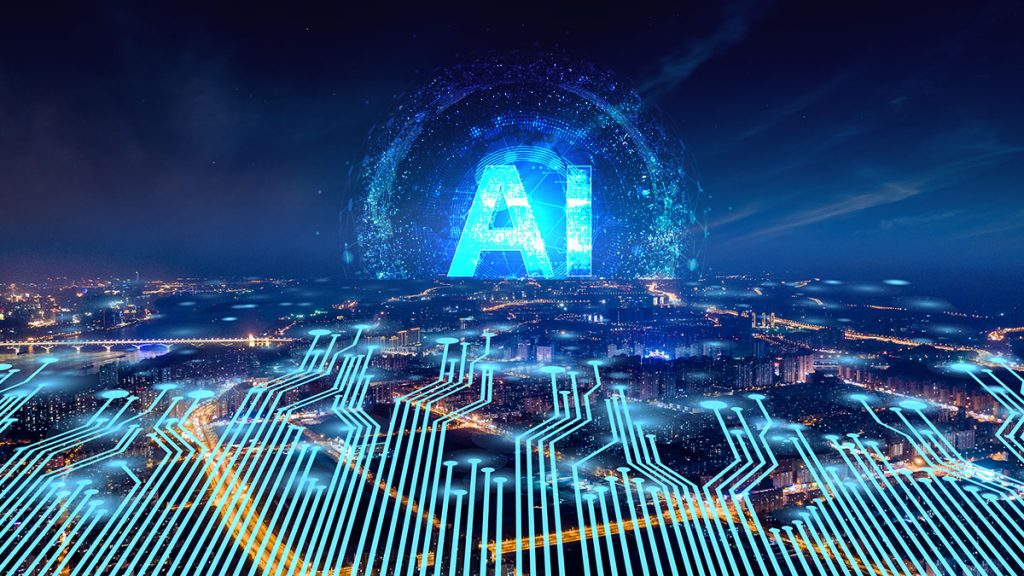 Modern city with wireless network connection concept
Modern city with wireless network connection concept Imagine a world where networks are sentient, self-healing, and self-optimizing. Where traffic flows seamlessly, and security threats are a thing of the past. This reality is the future of networking with AI, and it’s an exciting one. Artificial Intelligence (AI) has been making waves in various industries, and the networking world is no exception. With the ever-increasing demand for faster and more efficient networks, AI has become a game-changer in managing and optimizing networks. The intersection of this integration of two technologies is creating a new paradigm shift in the way we interact with technology. AI networking can revolutionize networking by making it more efficient, secure, and adaptable to changing conditions.
What Is AI for Networking?
AI techniques and algorithms are integrated into networking systems to improve performance, security, and automation. They allow networks to adapt and evolve dynamically, making them more intelligent and self-sufficient. The use of machine learning and AI is referred to as analyzing and controlling network behavior. AI-based solutions can analyze vast amounts of data in real-time and make intelligent decisions to optimize network performance and security. This can include that optimizing network performance, detecting and responding to cyber threats, and automating network management. For example, integrating AI solutions with network infrastructure is becoming increasingly important for companies to improve the performance of their networks.
Overall, the use of AI in networking has the potential to bring significant improvements in performance, security, and efficiency. By leveraging the power of machine learning and other AI techniques, can gain greater visibility and control over their connections and proactively address issues before they become significant problems. However, it is essential to note that while AIcan help to improve network performance and security, it is not a silver bullet and should be part of a comprehensive network strategy that includes other security and performance measures.
AI and Networking: A Perfect Partnership
AI and networking are two critical technologies that are rapidly advancing and transforming the way we live and work. Together, they have the potential to revolutionize the way we manage and optimize networks, making them more efficient, secure, and adaptable. Join us on this journey to explore the world of AI and discover how it’s changing the way we think about technology. It’s going to be a wild ride, and we can’t wait to see where it takes us!
Network Traffic Optimization
One of the most significant challenges facing networks today is traffic management. With the growing number of devices connected to networks, traffic management has become an important issue. AI algorithms can analyze web traffic in real-time, identifying patterns and anomalies that could indicate a potential problem. This allows network administrators to resolve issues before they cause major disruptions quickly. For example, researchers at the University of California, Berkeley, used AI to optimize network traffic by using machine learning algorithms to predict network congestion and adjust network settings accordingly. This resulted in a significant reduction in network congestion and an improvement in overall network performance.
AI Network Security
Another area where AI is making a significant impact is network security. Traditional security measures such as firewalls and antivirus software can only protect networks from cyber threats. On the other hand, AI-based security systems can learn and adapt to new threats, making them more effective at detecting and preventing attacks. For example, AI-based intrusion detection systems use machine learning algorithms to analyze web traffic and detect anomalies that could indicate a security threat. These systems can also learn from past attacks and adjust their security protocols accordingly to protect the network better.
Another example is that AI in 5G network security to monitor and protect the network from malicious activities. Machine learning models can be trained to identify and block malicious traffic, detect and respond to cyber-attacks, and improve overall security. This can include applications such as intrusion detection, firewall management, and security automation.
Automation
AI is also being used to automate repetitive tasks, thus freeing up network administrators to focus on more critical tasks. For example, AI can automatically provision new devices, configure network settings, and perform software updates, thus reducing the need for manual intervention.
Performance Optimization
With the increasing amount of data transmitted over networks, it has become increasingly important to ensure that networks run at optimal levels, hence optimizing the performance of connectivity. AI-based systems can analyze the performance of data, identify bottlenecks and inefficiencies, and adjust network settings to improve overall performance. For example, AI and ML in networking can be used to optimize the allocation of network resources such as bandwidth and storage.
Final Thoughts
AI is ushering in a new era of intelligent communication. With its ability to analyze and adapt to network conditions in real time. AI is revolutionizing the way we connect and interact with each other and the world around us. From autonomous cars to smart homes, the potential applications of AI networking are endless and have the power to enhance our daily lives greatly. As we move forward, we can expect even more innovative and exciting developments in this field as AI continues to push the boundaries of what is possible in networking.
Inside Telecom provides you with an extensive list of content covering all aspects of the tech industry. Keep an eye on our Intelligent Tech sections to stay informed and up-to-date with our daily articles.